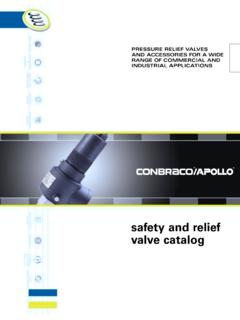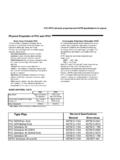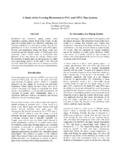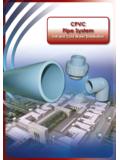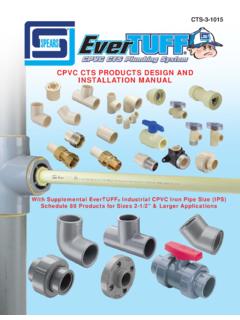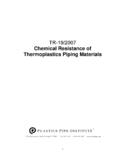Transcription of Chemtrol Valve Guide - Bay Port Valve
1 Chemtrol is a brand of Valve GuideChemtrol Thermoplastic Flow Solutions Introduction 1 Introduction to Chemtrol valves 1 Materials 1 Product Guide 2 Ball valves Three-Piece Style with Union Ends 2 True Union Ball valves 2 PVC & CPVC Tru-Bloc Ball valves 3 PVC & CPVC Bleach Ball valves 4 Polypropylene Tru-Bloc Ball valves 5 Kynar (PVDF) Tru-Bloc Ball valves 6 PVC & CPVC 3-Way Ball valves 7 Installation and Maintenance Instructions True Union End Style 8 Ball valves One-Piece 9 PVC Compact Economy Ball Valve 9 Butterfly valves 10 PVC/CPVC Butterfly valves ; Model-B 10 PVC Butterfly valves ; Model-C 11 Installation and Maintenance Instructions Butterfly valves 12 Check, Vent, and Foot valves 13 PVC, CPVC, PP.
2 And PVDF True Union Ball Check valves 13 Installation and Maintenance Instructions Ball Check valves 14 Globe valves 15 PVC Angle and Y-Pattern Globe valves 15 Installation and Maintenance Instructions Globe valves 16 Lab valves 17 PVC Chemcock and Calibrated-Needle valves 17 Installation and Maintenance Instructions Lab valves 18 Actuation Mounting Data 19 Ball Valve Mounting Data 19 Butterfly Valve Mounting Data 20 Valve Accessories 22 Reference Data 25 Engineering Data 26 Standards 29 Product Specifications 31 Product Line 34 Warranty 37 Copies of the Chemtrol Valve Guide and other Chemtrol publications are available for download on not use or test the products in this catalog with compressed air or other gases.
3 Revision 11/5 ContentsKynar is a registered trademark of Arkema not use or test the products in this catalog with compressed air or other gases. Revision 11/5 Introduction to Chemtrol ValvesWith more than 45 years of experience in industrial thermoplastics, Chemtrol offers dependable products that work in the most demanding s premium line of quality valves are lightweight, weather-resistant, and maintenance-free saving you time and money. For specific recommendations of chemical compatibility, see the Chemtrol Chemical Resistance Guide . For engineering data related to plastic piping system design, see the Chemtrol Thermoplastic Piping Technical Manual. And for the best thermoplastic fittings and flanges available for industrial use, refer to the Chemtrol Fitting Guide . These publications are available for download on in PDF format.
4 MaterialsPVC(Polyvinyl Chloride) PVC conforming to ASTM D-1784, Classification 12454-B, formerly designated Type I, Grade 1, is the most frequently specified of all thermoplastic piping materials. It has been used successfully for over 45 years in such diverse areas as chemical processing, industrial plating, chemical drainage, fresh and wastewater treatment, chilled and tower cooling water, deionized water manufacture and distribution, and irrigation sprinkler systems. PVC is characterized by high physical properties and resistance to chemical attack by strong acids and other oxidizers, alkalis, salt solutions, some organic chemical solutions, and many other chemicals. However, it is attacked by non-ionic surfactants, some vegetable oils ( , peanut), and many organic chemicals such as polar solvents ( , ketones), aromatics ( , benzene ring structure), and chlorinated hydrocarbons.
5 The maximum service temperature of PVC is 140 F. With a design stress of 2,000 psi at 73 F, the long-term hydrostatic strength of PVC is as high as any of the major thermoplastic materials being used for solid piping systems. PVC is joined by solvent cementing, threading, or (Corzan )(Chlorinated Polyvinyl Chloride) CPVC conforming to ASTM D-1784, Classification 23447-B, formerly designated Type IV, Grade 1, is a resin created by the post-chlorination of a PVC polymer. The material s resistance to chemical attack is almost identical to that of PVC. And the physical properties of CPVC are very similar to those of PVC at 73 F, but the additional chlorine in the CPVC polymer extends its maximum service temperature from 140 F to 210 F. For example, the design stress for CPVC is 2,000 psi at 73 F, identical to that of PVC.
6 But its strength is only reduced to 500 psi at 180 F, as compared to 440 psi for PVC at 140 F. For more than 35 years, CPVC has proven to be an excellent material for hot corrosive liquids, hot and cold water distribution, and similar applications above the useful temperature range for PVC. CPVC may even be chosen over PVC in the 110 F to 140 F temperature range because its higher strength-at-temperature, requiring less frequent piping supports, can translate to a more favorable overall installed cost than PVC. CPVC is joined by solvent cementing, threading, or (Kynar )(Polyvinylidene Fluoride) PVDF homopolymer conforming to ASTM D-3222, Type I, Grade 2, is a tough, abrasion-resistant fluorocarbon material that has a design stress of 1,360 psi at 73 F and a maximum service temperature of 280 F.
7 It has versatile chemical resistance to salts, strong acids, dilute bases, and many organic solvents, such as the aromatics ( , benzene ring structure), the aliphadics ( , paraffin, olefin, and acetylene hydrocarbons), and the chlorinated groups. And PVDF is ideally suited for handling wet or dry chlorine, bromine, and other halogens. However strong bases, hypochlorites, and some organic chemicals such as polar solvents ( , ketones) and esters attack it. No other solid thermoplastic piping material can approach the combined strength, working temperature, and chemical resistance characteristics of PVDF. It is joined by the thermo-sealing socket fusion process, threading, or basic PVDF resin is essentially transparent to ultraviolet (UV) radiation, and the plastic material is not degraded by sunlight.
8 However, the fluid medium in a PVDF piping system could be exposed to UV radiation. To provide protection against UV degradation of the fluid medium, an FDA-approved red pigmentation is added to all piping components for general industrial consumption, particularly for outdoor installations. Conversely, in certain industries, such as electronics, pharmaceuticals, and processed foods and beverages, PVDF has become the piping material of choice because of its high purity, low surface and joint extractables, and elevated temperature sanitation capability. For these applications, another line of piping products made from natural (unpigmented) Kynar is (Polypropylene) PP as specified by ASTM D-4101, is a member of the polyolefin family of pure hydrocarbon plastics. Although PP has half the strength of PVC and CPVC, with a design stress of 1,000 psi at 73 F, it may have the most versatile chemical resistance of the thermoplastic materials identified as the sentinels of industrial piping.
9 Consider the fact that there are no known solvents for PP. As a result, it has been the material of choice for drainage of mixed industrial chemicals for over 40 years. As pressure piping, PP has no peers for concentrated acetic acid or hydroxides. It is also suitable for milder solutions of most acids, alkalis, salts, and many organic chemicals, including solvents. The nemeses for PP are strong oxidizers, such as the hypochlorites and higher concentrations of sulfuric, nitric, and hydrofluoric acids. They are Environmental Stress Cracking (ESC) agents for PP, meaning that time-to-failure is a function of the combined variables of concentration and temperature of the fluid and stress in the piping material. Although PP is not recommended for some organic chemicals, such as polar and chlorinated solvents and the aromatics, the concern is permeation through rather than catastrophic damage of the molecular polyolefins are severely degraded by ultraviolet (UV) radiation.
10 However, the plastic piping industry recognizes that PP compounds, containing more than 2 1/2% carbon black pigmentation, are adequately UV stabilized to realize an outside service life of more than 25 years. Chemtrol utilizes such a compound to make all piping components for general industrial consumption, particularly for outdoor installations. Because of the high purity and low surface and joint extractables from natural (unpigmented) PP, Chemtrol utilizes an optimum compound to also make piping components for DI water systems. These are intended as an economic alternative to the ultra high purity infrared (IR) butt fusion PVDF systems typically found in the highly sophisticated electronic semi-conductor industry. It has been demonstrated that an appropriately designed serpentine system, constructed by mechanics properly instructed in the heat fusion of socket joints for sanitary piping, can consistently produce water conforming to the quality standards for injectable (Fluoroelastomer) FKM is compatible with a broad spectrum of chemicals.






